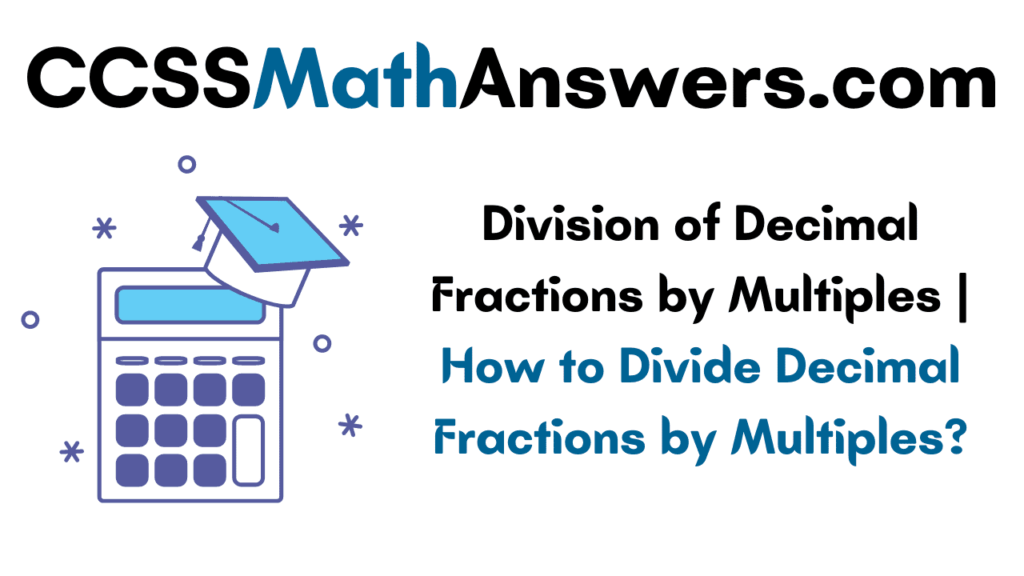The students of 5th grade can learn deeply about the division of fractions from here. The division of whole numbers is easy to calculate but the division of fractions is a little bit harder than the natural numbers. We can convert the fractions into the decimal form and then perform the division of decimal fractions by multiples. Here in this article, we will learn the steps on how to divide the fractions with some example problems. Practice the questions on the division of decimal fractions by multiples and test yourself.
Do Refer:
How to divide Decimal Fractions by Multiples?
In order to divide the decimal fractions by multiples, we have to follow certain steps. They are as follows.
Step 1. Write the given numbers in the division form.
Step 2. Now split the number in the denominator with a multiple of 10.
Step 3. Now divide the number with the multiple of 10.
Step 4. Write the quotient at the end.
Dividing Decimal Fractions by Multiples Examples
Division of decimal fractions by multiples are discussed with different types of examples in the below section.
Example 1.
Division of decimal fraction 145.1 with multiple by 20?
Solution:
145.1 ÷ 20
145.1/20
145.1/(2 × 10)
(145.1/2) × 1/10
= 7.255
Therefore 145.1 ÷ 20 = 7.255
145.1 is the dividend.
20 is the divisor.
7.255 is the quotient.
Example 2.
Division of decimal fraction 2.2 with multiple by 2.2?
Solution:
2.2 ÷ 30
2.2/(3 × 10)
(2.2/3) × (1/10)
0.73 × (1/10) = 0.073
Therefore 2.2 ÷ 30 = 0.073
2.2 is the dividend.
30 is the divisor.
0.073 is the quotient.
Example 3.
Division of decimal fraction 3241.8 with multiple by 300?
Solution:
3241.8 ÷ 300
3241.8/300
3241.8/(3× 100)
(3241.8/3) × (1/100)
0.73 × (1/100) = 0.073
Therefore 3241.8 ÷ 300 = 0.073
3241.8 is the dividend.
300 is the divisor.
0.073 is the quotient.
Example 4.
Division of decimal fraction 40.94 with multiple by 60?
Solution:
40.94 ÷ 60
40.94/60
40.94/6 × 10
(40.94/6) × (1/10)
6.82 × (1/10) = 0.682
Therefore 40.94 ÷ 6 = 0.682
Here 40.94 is the dividend.
6 is the divisor.
5 is the quotient.
Example 5.
Division of decimal fraction 200.4 with multiple by 100?
Solution:
200.4 ÷ 100
200.4/100
200.4/(1 × 100)
(200.4/1) × (1/100)
(200.4) × (1/100) = 2.004
Therefore 200.4 ÷100 = 2.004
200.4 is the dividend.
100 is the divisor.
2.004 is the quotient.
Example 6.
Division of decimal fraction 21.2 with multiple by 10?
Solution:
First divide 21.2 ÷ 10
21.2/10
21.2/(1 × 10)
(21.2/2) × (1/10) = 1.06
Therefore 21.2 ÷ 10 = 1.06
21.2 is the dividend.
10 is the divisor.
1.06 is the quotient.
Example 7.
Division of decimal fraction 428.1 with multiple by 100?
Solution:
First divide 428.1 ÷ 100
428.1/100
428.1/(1 × 100)
(428.1/1) × (1/100) = 4.281
Therefore 428.1 ÷ 100 = 4.281
428.1 is the dividend.
100 is the divisor.
4.281 is the quotient.
Example 8.
Division of decimal fraction 146.8 with multiple by 60?
Solution:
First divide 146.8 ÷ 60
146.8/60
146.8/(6 × 10)
(146.8/6)/(1/10) = 2.44
Therefore 146.8 ÷ 60 = 2.44
146.8 is the dividend.
60 is the divisor.
2.44 is the quotient.
Example 9.
Division of decimal fraction 36.2 with multiple by 40?
Solution:
First divide 36.2 ÷ 40
36.2/40
36.2/(4 × 10)
(36.2/4)/(1/10) = 0.905
Therefore 36.2 ÷ 40 = 0.905
36.2 is the dividend.
40 is the divisor.
0.905 is the quotient.
Example 10.
Division of decimal fraction 11.1 with multiple by 10?
Solution:
First divide 11.1 ÷ 10
11.1/10
11.1/(1 × 10)
(11.1/1) × (1/10) = 1.11
Therefore 11.1 ÷ 10 = 1.11
11.1 is the dividend.
10 is the divisor.
1.11 is the quotient.
FAQs on Dividing Decimal Fractions by Multiples
1. How do you write a decimal fraction?
Decimals can be written in fraction form. In order to convert the decimal to a fraction place the decimal number over its place value.
2. What is 0.75 as a fraction?
0.75 can be expressed in the fraction form as 3/4.
3. What are decimal fractions called?
The fractions whose denominator is 10 or higher powers of 10, i.e., 100, 1000, 10,000, etc., are called decimal fractions.
